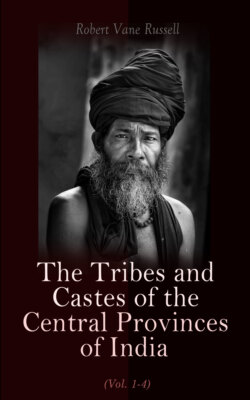Читать книгу The Tribes and Castes of the Central Provinces of India (Vol. 1-4) - Robert Vane Russell - Страница 16
Parmārthi Sect
ОглавлениеParmārthi Sect.—A Vishnuite sect of which 26,000 persons were returned as members in the census of 1901. Nearly all of these belonged to the Uriya State of Kālāhandi, since transferred to Bihār and Orissa. The following account of the sect has been furnished by Rai Bahādur Panda Baijnāth, formerly Diwān of Kālāhandi State.
This sect penetrated the State from the Orissa side, and seems to belong to Bengal. In the beginning it consisted only in pure devotion to the worship of Krishna, but later it has been degraded by sexual indulgence and immorality, and this appears to be the main basis of its ritual at present. Outwardly its followers recite the Bhāgavad Gīta and pretend to be persons of very high morals. Their secret practices were obtained from one of his officials who had entered the sect in the lowest grade. On the day of initiation there is a great meeting of members at the cost of the neophyte. A text is taught to him, and the initiation is completed by all the members partaking together of a feast without distinction of caste. The food eaten at this is considered to be Mahāprasād, or as if offered to Vishnu in his form of Jagannāth at Puri, and to be therefore incapable of defilement. The mantra or text taught to the disciple is as follows:
O Hari, O Krishna, O Hari, O Krishna,
O Krishna, O Krishna, O Hari, O Hari,
O Hari, O Rāmo, O Hari, O Rāmo,
O Rāmo, O Rāmo, O Hari, O Hari.
The disciple is enjoined to repeat this text a prescribed number of times, 108 or more, every day. To those pupils who show their devotional ardour by continual repetition of the first text others are taught.
The next step is that the disciple should associate himself or herself with some other Parmārthi of the opposite sex and tend and serve them. This relation, which is known as Asra-patro, cannot exist between husband and wife, some other person having to be chosen in each case, and it results of course in an immoral connection. Following this is the further rite of Almo-Samarpana or offering of oneself, in which the disciple is required to give his wife to the Guru or preceptor as the acme of self-sacrifice. The guru calls the disciple by a female name of one of the milkmaids of Brindāban to indicate that the disciple regards Krishna with the same devotion as they did. Sometimes the guru and a woman personate Krishna and Rādha, but reverse the names, the guru calling himself Rādha and the woman Krishna. The other disciples wait upon and serve them, and they perform an immoral act in public. Parmārthi women sometimes have the mantra or text, ‘O Hari, O Krishna,’ tattooed on their breasts.
The Parmārthis often deny the accusation of immorality, and the above statements may not be true of all of them; but they are believed to be true as regards a considerable part of the sect at any rate. “With all his cleanliness, vegetarianism and teetotalism,” one writer remarks, “the Vaishnava is perhaps the most dangerous in the whole list of Hindu sects. He has done very good service in civilising the lower classes to some extent and in suppressing the horrors of the Tāntric worship. But the moral laxity which the Vaishnava encourages by the stories of the illicit loves between the God and Goddess, and by the strong tendency to imitate them which his teachings generate, outweigh the good done by him.” This statement applies, however, principally to one or two sects devoted to Krishna, and by no means to all nor to the majority of the Vaishnava sects.
